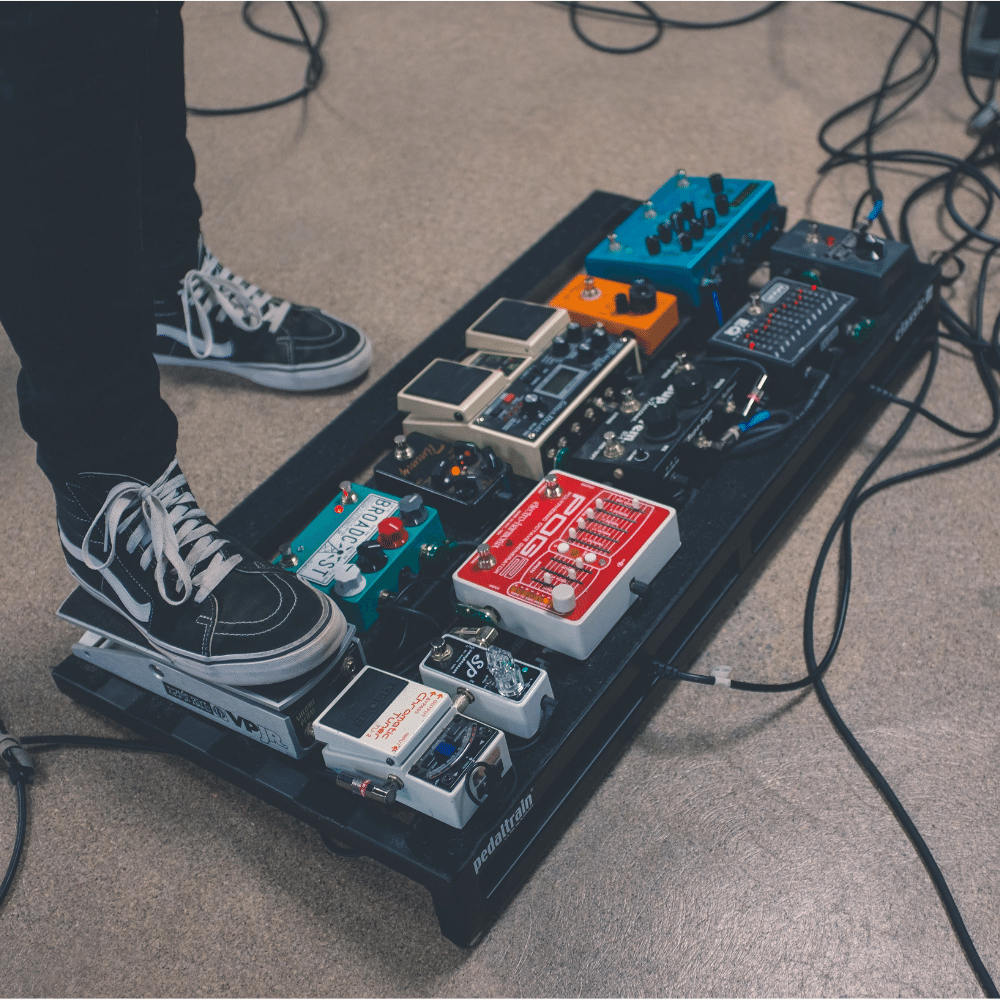Finding the Best Buffer Pedal to Save Your Signal
Learn the features to look for and how to choose the best buffer pedal for your budget and situation, along with our Top 5 recommendations!

Buffer pedals are a type of effect used to maintain the signal strength and integrity of your guitar's sound when it passes through long cable runs or multiple pedals in a chain. By keeping the signal strong, buffer pedals help to prevent any unwanted noise or tone loss from occurring. Many guitarists use buffer pedals in front of their distortion or overdrive to help keep their sound clean, clear and punchy, and to help offset any impedance mismatches between different types of pickups and guitar cables.
You'll need to decide what features you need. For example, some buffer pedals have an EQ section that allows you to shape the sound of your guitar's signal, while others have a tuner, a boost function that gives your signal a volume boost, or a mute switch to do the opposite. The best option for you depends on your specific needs, so read on below to find out about the best buffers available today.
MOSKYAudio Mini Clean Buffer Effect
Why it Rocks
When it comes to getting the best possible sound from your guitar, you need a clean buffer that can deliver a robust, natural sound without any loss of signal or outputs. This buffer is just the thing for solving weak guitar sounds caused by using too many pedals and other effects, while simultaneously decreasing distortion. Plus, with its compact size (dimensions of only L 3.5in x W 1.4in x H 1.2in) and durable construction, this buffer is ideal for crowded pedalboards at live performances.
What Else
With its pure signal path, this small but powerful buffer pedal delivers pure, natural output that sounds just like you are plugged straight into your amp. And the incredibly simple interface (featuring basically nothing but an ON/OFF LED indicator light) means very little room for operator error.
JHS Little Black Buffer Guitar Signal Buffer
Why it Rocks
Adding a JHS Little Black Buffer to your signal path is a great way to restore the high-end detail, output impedance level, and tonal character that can be lost as your signal travels through long cable runs and complex chains preserving the original sound of your guitar, without introducing any unwanted noise or loss along the way.
What Else
Its compact size and durable construction make it a great choice for players who want to save precious real estate on their pedalboards by mounting it underneath, while its black powder coating ensures that this pedal remains hidden in the background of your rig. An active buffer that's super-dependable and easy to integrate into your pedal setup.
TC Electronic BONAFIDE Buffer
Why it Rocks
With superior analog buffering, its input impedance of 1M ohms helps it to build up a strong signal at the input, while its output impedance of 100 ohms enables this buffer to release that power effortlessly. This combination makes it ideally suited for long cable runs, where maintaining optimum signal strength is crucial. And to make things even better, this pedal features an intelligent buffered bypass relay that will automatically switch to true bypass if power is cut, so your guitar sound will always come through fully intact.
What Else
Having such high input impedance can also make a buffer prone to excess noise; but thanks to its excellent signal-to-noise ratio of more than 112 dB and Total Harmonic Distortion rating of 0.001%, the BONAFIDE BUFFER is able to deliver crystal clear audio with no unwanted distortions or background noise.
Empress Effects Buffer Plus Boost
Why it Rocks
Designed to be the complete I/O interface for the pedalboard, the Empress Effects Buffer Plus Boost pedal is a high-fidelity device that is designed to eliminate signal loss output and ensure that your guitar sound stays unchanged by your cables. And thanks to its streamlined layout, setting up and configuring your pedalboard via Empress has never been easier.
What Else
This Empress buffer features noise filter switch, input pad switch, clean boost switch and input loading - enabling you to fine-tune your effects loop in a variety of ways, from reducing noise and controlling distortion to utilizing different input loads.
Fender Level Set Buffer
Why it Rocks
Fender's Level Set features level, hi-freq, and load controls to adjust your signal strength and fine-tune your tone; it also comes with a main mute footswitch for silent tuning and a tuner output that allows you to keep your tuner on at all times without interrupting your signal path.
What Else
This high end quality pedal offers precision level and hi-frequency trim controls, along with a main mute footswitch for silent tuning and led backlit knobs for on-the-fly adjustments. Additionally, it features a Fender amp jewel LED and magnetically latched hinged 9V battery door for easy access when you need it.
Frequently Asked Questions About Buffer Pedals
When should you use a buffer pedal?
You should use buffer pedals when you have a lot of gear that you're switching between, or when your signal is weak and needs to be strengthened.
They can be particularly useful for guitarists who have a lot of pedals on their pedalboard, because it helps to keep the signal strong as it travels through all of the devices. It's also great for players who have weak pickups in their guitar, because it can help to strengthen the signal and make it louder.
Additionally, buffer pedals should be used when you have a long cable run between your guitar and your amplifier, or when you have multiple instruments plugged into the same amplifier, as it can help to prevent loss and degradation, which can result in a degraded tone and decreased signal strength.
How many pedals until you need a buffer?
It depends on the type of pedal and the type of buffer.
Generally, if you have more than three pedals in your chain, you'll need a buffer to prevent loss and degradation. However, if you have a high-quality digital delay or reverb, it can act as a buffer for your entire board. So it really depends on the specific setup and how many of the pedals are analog vs. digital.
Also, the first pedal in the chain would not need a buffer because the guitar's signal already has a built-in buffer circuit (i.e., the pickups).
If you're not sure whether or not you need a buffer, try plugging your guitar directly into your amp without any effects loop in between. If it sounds better that way, then you probably need a buffer in your chain.
Can you have too many buffer pedals?
It is possible to have too many buffer pedals, but it really depends on the signal chain and how each pedal is configured. For example, if you have four or five buffer pedals in a row, they could potentially create a lot of noise and interference. However, if the pedals are staggered properly and used sparingly, they can be a great way to keep your sound consistent from gig to gig.
But if each of your buffer pedals is performing a specific function—such as eliminating noise, protecting your tone, or extending the life of your cables—then more buffers might be necessary to achieve the desired results.
Is true bypass better than buffered?
It depends on what you are trying to achieve.
A true bypass pedal is more transparent and has a quicker reaction time than a buffer pedal. This makes it better for players who want to get the most natural sound output possible from their guitar. However, a buffer pedal will help to prevent loss and noise in long signal chains or when used with vintage amps and guitars. For these applications, a buffer pedal is often preferable.
How do I know if my pedals are true bypass?
There are a few ways to test for true bypass pedals:
(1) Unplug the pedal from your signal chain, listening for a change in tone (there shouldn't be one);
(2) Use a multimeter. Unplug the pedal from your guitar and measure the resistance between the input and output jacks with the pedal switched off (there should be no resistance);
(3) Finally, some bypass pedals have an LED that lights up when the effect is on (so when it is off, the LED should be dark).
Summary of the Best Buffer Pedals
Buffer pedals are certainly worth it for a lot of guitarists. A buffer circuit can help to keep your sound consistent from gig to gig, and they can also help to prevent any unwanted noise or hum from entering your signal chain.
Buffer pedals are also definitely worth considering if you play a lot of live shows or use a lot of guitar effects pedals in your studio recordings.
A good buffer will help to keep your tone clear and consistent no matter how many effects pedals you have chained together or how long your loop is. They also help to prevent loss and degradation when using long cables or running lots of power through your pedalboard.
Hopefully this article has proved helpful in find the best buffer pedals for you - here again are our top picks from above:
Best for a Small Footprint: MOSKYAudio Mini Clean Buffer
Best for a Low Profile: JHS Little Black Buffer
Best Value for the Money: TC Electronic BONAFIDE Buffer
Best for a Complete Interface: Empress Buffer Plus Boost
Best Overall: Fender Level Set
Thanks for checking us out, and keep rockin’.
*FYI, when you make a qualifying purchase through one of our links, we might receive a small commission from Amazon or other retailers, at no additional cost to you, which helps us to fund this site. It's a way to find what you're looking for while supporting us in the process!





